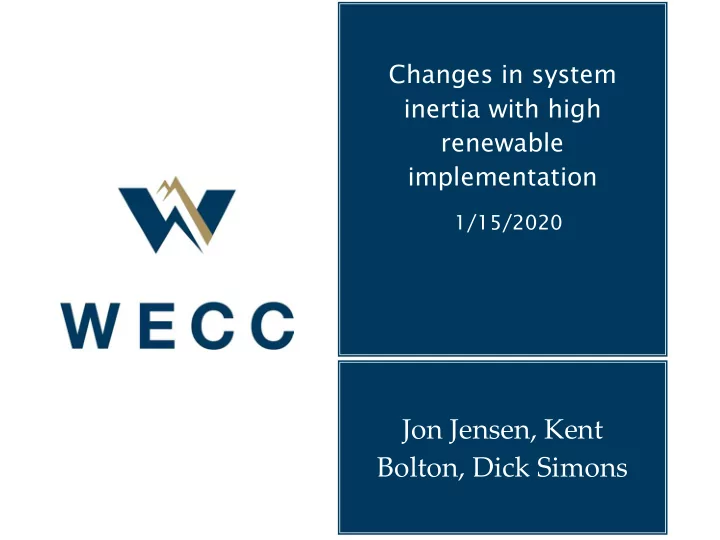

Changes in system inertia with high renewable implementation 1/15/2020 Jon Jensen, Kent Bolton, Dick Simons
SITF ▪ This study was performed through the System Inertia Task Force (SITF). A group of stakeholders and subject matter experts. 2
Purpose ▪ Assess impact on reliability of Bulk Electric System (BES) in the Western Interconnection (WI) as inertia decreases from retirement of coal resources and addition of Inverter Based Resources (IBR) by assessing the following: • Frequency response • Reliability impact • Transient voltage stability • Impact of IBR with/without frequency response capability • Crucial contingency changes • Transmission path loading change • Short circuit fault duty • Resource adequacy • Capital cost of added IBR 3
Assessment Approach ▪ 2028 Anchor Data Set (ADS) Phase 2 V2.0 ▪ Retire 100% of coal resources ▪ Add Wind/Solar/Battery to replace coal resources ▪ Select hours of PCM to study in PowerFlow ▪ Dynamic and contingency analysis ▪ Capital cost ▪ Fault current analysis 4
Resource conversions ▪ Alberta Unit Name Capacity, MW Sheerness_2_2 408 Sheerness1-1 408 Genesee_2_2 422 Genesee1-1 422 Genesee_3_3 527 Keephills3_1 498 Total: 2,685 5
Resource retirements Total of 18,976 MW coal retirements, 21,661 MW including Alberta resource conversions 6
Resource Additions Total of 115,840 MW added capacity 7
MW Comparison 8
Energy Comparison 9
PowerFlow hours to analyze 10/28/2028 8/4/2028 10
8-4-2028 ▪ Hour 5198 (8-4-2028 hour 14) • Generation = 135,972 MW • IBR/Sync = 2.02 11
Path Flow 12
Paths 13
Inter-regional transfers 14
Inertia • SITF case has about 62% of the Inertia as the Phase 1 case. • Note MVA on plot does not include IBR MVA, synchronous only. 15
Inertia • We see decreased inertia where coal was removed • Other differences due to dispatch/load differences between cases 16
System Cost $/MW for a 1MW System-E3 17
Capital Cost 18
Capital Cost – 2023 Install year 19
LCOE-Energy Price $/MWh ▪ Levelized Cost of Energy (LCOE) represents the energy price output needed to recuperate the cost of the plant over its estimated lifetime. CCGT has an LCOE of about $48/MWh 20
Fault Current ▪ Plot shows decreasing fault current only ▪ IBR vs Synch machine fault current ▪ Difference in 28HS1 vs SITF (Dispatch difference) ▪ Reliability concerns ▪ Geographic information system (GIS) data for about half of the busses 21
Dynamics The Standard Disturbances include: ▪ Chief Joe Brake insertion • Insertion for 30 cycles and then removal of the large braking resistor in the Northwest ▪ Double Palo Verde Outage • Simultaneous tripping of two Palo Verde generation units ▪ Colorado River Red Bluff Outage • 3 phase fault with tripping of two transmission lines in Southern California ▪ Gates – Midway and Diablo-Midway Outage • 3 phase fault with tripping of three transmission lines in Northern California ▪ Brownlee – Hells Canyon Outage • 3 phase fault with tripping of one large transmission line in Idaho. This includes the approximation of an associated Remedial Action Scheme (RAS). ▪ Daniel Park – Comanche Outage • 3 phase fault and then tripping of two large transmission lines in Colorado ▪ Pacific DC Intertie (PDCI) Block • Simulates a block (removal of the lines from service) of the DC line from Celilo (in the Northwest) to Sylmar (in Southern California) 22
Dynamics double PV outage (units 1 & 2) f nadir f delt response RoCoF ADS 59.86461 0.136112 2018.335 -0.027 SITF 59.77664 0.223797 1168.739 -0.13564 F nadir is in Hz, fdelt is in Hz, f response is in MW/.1 Hz and RoCoF is in Hz/s. 23
Observations ▪ Six times as much IBR generation capacity needed to replace the coal capacity due to capacity factor differences. ▪ … 24
Recommendations ▪ Updating all Short Circuit Model busses with GIS data to more fully represent system on map plot; ▪ Completing additional Short Circuit analysis in CAPE/Aspen where one case has all coal removed and the other one includes coal to include Zero and Negative sequence; ▪ Completing autumn Power Flow and dynamics analyses; ▪ Studying dynamics where frequency response and voltage regulation capability is turned on for all IBR; ▪ Evaluating differences in Path flow loading and run contingencies on related loaded paths; ▪ Analyzing in greater depth the impact on reliability from the addition of energy storage (Batteries/CAES); ▪ Evaluating possible mitigation techniques for path overloads; and ▪ Optimizing the system for the best mix of energy storage and renewables. 25
Contact: Jon Jensen Kent Bolton Dick Simons 26
Recommend
More recommend